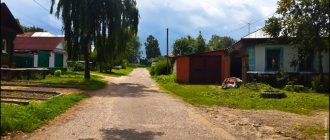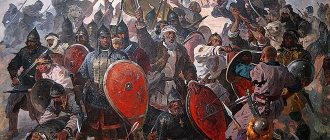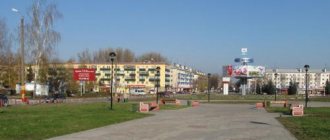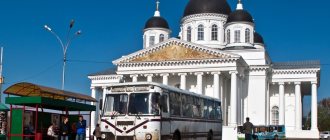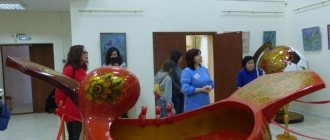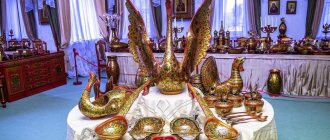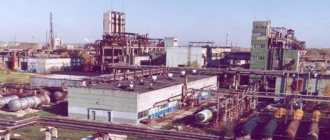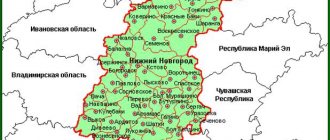Content
- 1 History of the founding of the city
- 2 Wood-earth fortifications of Gorodets
- 3 Revival of Gorodets after the invasion of Batu’s troops
- 4 Gorodets in the XIV-XVI centuries
- 5 Gorodets in the 17th-19th centuries
- 6 Archaeological excavations on the territory of Gorodets
- 7 Architectural monuments 7.1 Fedorovsky Monastery
- 7.2 Michael the Archangel Church
- 7.3 Trinity - Nikolsky Pogost (Cathedral)
- 7.4 Church of the Vladimir Mother of God
- 7.5 Spasskaya Church
- 7.6 Assumption Edinoverie Church
History of the founding of the city
Gorodets is the most ancient city in Nizhny Novgorod, almost the same age as Moscow. In 1152, Yuri Dolgoruky, having crossed the ancient river Ra at the place where Unzha flows into it, reached the heights where he found the village of Maly Kitezh. There was a small monastery here where the first Russian settlers, monks, lived. Yuri founded a city here and gave it the name Gorodets - Radilov, which means Gorodets on the Volga or Volzhsky Gorodok. There is another version of the explanation for the name. In 1147, Radil was the ambassador of Prince Izyaslav Mstislavovich to the people of Kiev and spoke at a meeting at St. Sophia. Later, he apparently found himself surrounded by Yuri Dolgoruky and, when he left for the Rostov-Suzdal land, he became his confidant during the founding of Gorodets, leaving his name as a clarifying name for the ancient city for centuries.
The choice of the Gorodets construction site was determined by its purpose - control and protection of salt production. Salt was highly valued and was often the same monetary equivalent as gold, silver, and furs. The military river ships of the town residents, constantly stationed in the bays under the city, forever blocked the Bulgars’ path along the Volga deep into the Russian lands, and the city itself became a gathering place for Russian squads and their preparation for campaigns in the Ponizov region, a place of diplomatic meetings and negotiations, the great Vladimir-Suzdal princes with the peoples who held power in the area between the Oka and Volga rivers.
The initial place of origin of ancient Gorodets was the area of the Prince's Mountain. The fortress ramparts of Gorodets around Detinets and Posad had the shape of two concentric arcs, the ends of which faced the Volga. The shaft was made of pure continental sand, construction lasted 30 years, the earth had to be carried in buckets and even in hems and hats. The eastern slope of the shaft had a steepness of up to 40%. The length of the shaft was about 2100 meters. The Posad shaft had three passages with towers and gates.
Already in 1155, Gorodets became the center of the Rostov-Suzdal principality, acquiring the significance of a transshipment point on trade routes from Vladimir, Suzdal, and Rostov the Great.
At the behest of Prince Yuri Vladimirovich, the construction of the St. Michael the Archangel Cathedral, as well as the famous Fedorov Monastery, began.
Prince Yuri Dolgoruky did not rule Gorodets for long. He handed over the management of the city to his son Vasily, who was the first appanage prince of Gorodets.
Chronicle data
According to chronicle sources, about a dozen “gorodtsy” are known in Ancient Rus'. This could lead to confusion, and therefore forced geographical clarifications. But it is noteworthy that in the article “Names of Russian cities” (late 14th century) only Gorodets (Radilov) is listed without geographical specifications. This indicates the fame and importance of the city. In the article of 1216 of the Novgorod I Chronicle it is said: “... Gyurgi went from Volodymyr to Radilov Gorodch...”. In the Novgorod IV and Sofia I chronicles, as well as later codes, there are clarifications: “Prince Mstislav and Volodymer governed them, Prince Kostyantin Volodymer, and Prince Yurya Radilov Gorodets... And so the set hid on the boats, in the nasads, the ruler, and the princesses, and his [Yuri’s] people all went down... And so they went from Volodymer in Male to Gorodets.” The context of this news (“hidden on the boat... everything went down”) shows that it meant Gorodets-on-Volga, from where Yuri returns through Suzdal.
Gateways on the Volga in Gorodets
Why is Gorodets called Radilov here? This entry exists in the Novgorod Chronicle, but in the Laurentian Chronicle Gorodets is never called Radilov. Describing the return of Prince Yuri, early codes call the city simply Gorodets (the clarification “Radilov” appears only in two later codes - the Nikon Chronicle and the Tver Collection). And the news from the Tver collection about the death of Prince Mikhalko “on Volz on Gorodets on Rodilov” is a distortion of the original text.
Another mention of the toponym “Radilov”, but without the word “gorodets”, is only among the list of cities of the Tver land in the chronicles of the Novgorod-Sofia group. On the territory of the Nizhny Novgorod region (province), the toponym “Radilov” does not occur at all. Most likely, a mistake by the Novgorod chronicler crept into the history of the name of the city, which was continued in the vaults of the 16th century. (According to research by Pudalov B.M.)
Wood-earth fortifications of Gorodets
Three lines of fortifications, which formed the system of its defense in the first decades of the city’s existence, remain a unique monument of Gorodets antiquity. True, the ramparts of the fortress were practically razed and the ditch of Knyazhya Mountain, the heart of Gorodets on the Volga, was filled in. Powerful fortifications of the settlement were not preserved along the entire perimeter. And the fortress ramparts of the settlement were erected by ancient builders only to a height of 2.5-3 meters, and they were abandoned like that, giving rise to a lot of unanswered questions among researchers about the reasons for this.
The Gorodets fortifications of the 12th – 13th centuries remain a truly unique focus of three lines of fortress of a medieval Russian city, rare not only for the Nizhny Novgorod Volga region, but also for the entire country. They can be used to study the general principles and features of domestic defensive architecture of the pre-Mongol period, but the fortress system of Gorodets was explored only in 1960-1962 by Moscow archaeologist A.F. Medvedev.
The construction of the Gorodets fortress began with the construction of a ditch and ramparts of the Prince's Mountain (Detinets), which was a flat, elevated plateau of the left, here high bank of the Volga, on the sides limited by deep ravines - washouts formed by spring catchments and erosion of soft clayey coastal rocks.
Ramparts and ditches (about 550 meters) encircled Prince Mountain in an arc, breaking off at the ends with screes towards the Volga. Detinets occupied only 3.5 hectares. The width of the base of the rampart was 22 meters, and the width of the ditch was 18 meters, with a total height of the rampart embankment of up to 7 meters. Archaeologists also revealed the process of constructing the Prince's Mountain: first, the width of the ditch and the fortress rampart was determined, and then the earth was transferred from the edge of the floor side of the ditch to the opposite edge of the rampart, in order to save people's efforts as much as possible. At the same time, the slope of the shaft slopes was also taken into account. As the shafts were filled, the climb up it became steeper, but the distance from the digging site to the dumping site turned out to be shorter and shorter. At the final stage of the work, the buckets of earth were lifted upward using a device in the form of a well “crane.” The fortress moat of Prince Mountain was 5.15 meters deep with a sharpened piece at the bottom. The stakes had a diameter of 8-12 cm with a length of up to 70 cm, and were stuck slightly obliquely towards the field.
Just remember that the wooden-earth Russian fortresses in the 12th century did not have towers, and the walls were made up of gorodneys placed along the crest of the rampart - log houses the length of a log (10-15 m), filled inside for stability and reliability with earth and cartilage (stone , remains of ceramic production and waste from forges). To enter the territory of the detinets, a bridge was cut across the moat on rezha (wooden cages), and a powerful gate device was launched up to the mainland, which was a huge chopped road tower with a bridgehead barbican and cut with half-height joists, on which earth and cartilage were poured. In the event of an enemy attack, the ends of the logs were cut off, and they, along with the cartilage, fell down, creating a blockage that was difficult for the enemy to overcome. An additional element of the defense of the gate device was the bridgehead barbican - a stockade, behind which the defenders of the gate took cover at the beginning of the siege, and then it was burned on the spot.
To protect the craft settlement that had grown around the village, wood-earth fortifications had to be hastily erected. Already in plans it was supposed to become a fortress, the perimeter of the ramparts of which was 2100 meters. The width of the base of the shaft reached 33 meters with an embankment height of 9 to 15 meters. Among the fortifications of other cities of Ancient Rus', the Gorodets ramparts were second only to the height of the embankment ramparts of Kyiv, which testified to some special purpose of Gorodets Radilov, who, since its foundation, had never allowed military caravans of Bulgar ships to pass along the Volga deep into the Russian lands.
Gorodets Museums
Gorodets Museum Quarter
Russian samovar tower
I really didn’t think that the Samovar Museum in Gorodets would give Tula a head start, with which this item of Russian everyday life is primarily associated. I recommend taking the excursion, otherwise you will not get that boost of energy that the museum employee dressed in a national sundress generously gives. He will talk about the most interesting samovars from the collection, sing songs, so much so that many visitors could not resist and spontaneously organized a choir.
Address: st. Embankment of the Revolution, 11, www.gorodets-travel.ru.
Russian Samovar Museum in Gorodets
Gallery of goodness
I took the name of the museum in its literal sense, so I wondered to myself what could be presented in the exhibition to tell about human goodness and joy? It turned out that good means something that is “acquired through backbreaking labor.” I was impressed by the collection of assorted locks and keys, various household items, as well as a real treasure that everyone would like to find. The house in which the museum is located previously belonged to the merchant T.A. Plekhanov. The condition of the building is excellent; thanks to the initiative of the creator of the exhibition, Gorodets preserves traditional architecture.
Contacts: Nizhny Novgorod region, Gorodets, st. N. Revolyutsii, 10, link to the site is given above.
Gallery of goodness
Gorodets Local Lore Museum
Occupies the remarkable mansion of the merchant I.P. Oblaeva
Contacts: Nizhny Novgorod region, Gorodets, st. Lenina, 11, www.gorodmuseum.ru
Gorodets Local Lore Museum
Museum "Gorodets Gingerbread"
Contacts: Nizhny Novgorod region, Gorodets, st. Gorodets, st. Lenin st., 2,
website: www.gorodmuseum.ru
Oddly enough, what struck us most in the gingerbread museum was the chest of drawers - an example of virtuoso woodwork. There was no excursion for the two of us; they offered a master class, but we did not have the necessary time for this. We briefly examined the small museum ourselves: various forms of gingerbread, recipes, cooking tools... We bought a gingerbread at the souvenir shop for the path and, chewing the spoils, walked to the next museum.
Gorodets Gingerbread Museum
Museum "House of Countess Panina"
Contacts: Nizhny Novgorod region, Gorodets, st. Gorodets, Rublev St., 16,
website: www.gorodmuseum.ru
The atmosphere of the museum takes you back to the distant times of lordly life. The most amazing exhibits were the musical instruments of those years: gramophones, gramophones, the caretaker even started a music box for us. Fascinated by the sounds, we looked around other rooms of the estate and saw many clocks and books of that time. In addition to the exhibition, the house of Countess Panina is interesting from an architectural point of view, because there are practically no estates in the wooden Empire style left in Russia.
House of Countess Panina
Children's Museum on Kupecheskaya
Contacts: Nizhny Novgorod region, Gorodets, st. Lenina, 12,
website: www.gorodmuseum.ru
We didn’t have time to visit this museum, but the website says that inside there is a model of a school class with old school paraphernalia, as well as many handmade dolls.
Public “Museum of Memory of Alexander Nevsky”
Operating mode:
Every day from 9-00 to 18-00.
Order excursions by phone. 8(83161)925-43 or 8 910 381 11 37
The duration of the excursion is from 20 to 40 minutes.
Admission is free, you can leave donations for the development of the museum
Located on the second floor of the house of the merchant G.I. Tyukalov - D.N. Lapshina
Museum "Gorodets on the Volga"
Contacts: Nizhny Novgorod region, Gorodets, st. Lenina 9,
website: www.gorodmuseumgorodec.ru
The museum exposition tells about the life of citizens of various professions: merchants, doctors, firefighters, etc.
Revival of Gorodets after the invasion of Batu’s troops
In 1238, Batu's Tatar troops burned Gorodets to the ground. The earthen rampart turned out to be impregnable for enemies, but it had one weak point: it had a wide gate. The Mongol cavalry - the Tatars - burst into them.
After the invasion of Batu's troops, the city was rebuilt. In the second half of the 13th century, the Fedorovsky Monastery, the Cathedral of the Archangel Michael, which became the tomb of local appanage princes, and city fortifications, which in the 14th century served as reliable protection for the population from passing Tatar troops, were restored in Gorodets.
A bright page in the history of Gorodets is an event associated with the name of the great commander of ancient Rus', Alexander Nevsky. In 1263, he died here in one of the cells of the Fedorov Monastery, returning from the Khan's headquarters of the Golden Horde. At that time, Alexander Nevsky’s brother Andrei reigned in Gorodets.
During the second half of the 13th century, Gorodets was first under the control of Georgy Andreevich, and then by the son of Alexander Nevsky, Andrey. True, Nevsky’s son did not gain fame as a defender of the Russian land, but on the contrary, pursuing selfish interests, he more than once began internecine feuds with his brother Dmitry Pereslavsky. Despite this, he also found his last refuge on July 27, 1304 in Gorodets in the St. Michael the Archangel Cathedral.
According to established traditions, his son Mikhail Andreevich immediately went for a label to the Gorodetsky knot in the Horde, but while he was there, “black” people killed the boyars in Nizhny Novgorod and established a veche republic. True, it did not last long, less than a year.
The above facts eloquently indicate that Gorodets, after the Mongol-Tatar pogrom of 1238 and 1239, quickly regained its former significance as a major political and economic center of North-Eastern Rus'.
History and sights – tourist walk
The main objects of Gorodets are the rampart and the moat; they appeared here back in the 19th century. These are monuments of the ancient Russian fortification direction of all-Russian significance. A rampart and a moat surround the settlement on the northern, eastern and southern sides. The length is 2100 meters. Previously, the planting area was 60 hectares. There was a princely residence here.
Despite the fact that quite a lot of time has passed, the shaft has retained its monumentality. Today it is surrounded on all sides by massive pine trees, and a forested park area has been established.
The architecture of the ancient city is rich. The features of a merchant settlement began to be visible in the 19th century. Currently, you can admire the abundance of wooden and stone buildings from the 19th and 20th centuries. The central part is characterized by colorfulness and uniqueness. The layout is adjusted to the features of the landscape. The streets turn to the Volga. There is a market right next to the shore, and luxurious mansions have been built in the mountainous area. Every picturesque street is imbued with the spirit of a provincial, merchant town. The space around is filled with a leisurely and peaceful atmosphere.
Most of the neighborhoods have not changed. The streets of Maxim Gorky, Lenin, Andrei Rublev, Alexander Nevsky, Trinity Congress remind of the past. The observation area offers a stunning view of Maxim Gorky Street. Here stands a rich merchant's house, framed with sawn carvings. There is a sign on the porch with the owner’s initials – “GAN”.
The Lemekhov estate deserves special attention. This is a beautiful and monumental structure. Today the Gorodets Music Pedagogical College operates here. After the estate you can see the large ramp. It smoothly turns into Kirov Street.
Getting onto the streets of Kirov, the eye immediately stops at an ancient object - this is a leisure building. Previously, a public meeting was organized here. The Art Nouveau object from 1907 is incredibly beautiful. Architect – Pavel Dombrovsky. Nearby there is a monument to the “Merchants of Russia”.
The buildings of the local peasantry advantageously combine elements of urban and rural culture. Platbands, gutters, palisade, porch, forged elements, combined with each other, create a special atmosphere. The construction of many houses was carried out under the influence of folk architecture. The former house of the merchant Tryapkin was built in the Art Nouveau style. Today there is an ambulance station here.
The building of the RCC of the State Bank of Russia immediately catches the eye, attracting with its unusualness.
It was built on the basis of provincial classicism, made of red brick.
The printing house building located on the street is incredibly beautiful and colorful. Andrey Rublev, 15. This is the editorial office of the local newspaper “Vestnik”. The turquoise color and sawn carving of the building effectively decorate the embankment.
A walk along the Volzhskaya embankment will seem fascinating. Citizens and tourists love this place. The famous monument to Alexander the Second is mounted here. There are many ancient houses everywhere, which are richly decorated with carvings. It is impossible to pass by the house of the merchant Pugin-Korytnikov without admiring it.
There is a small memorial on the Embankment, which is dedicated to front-line soldiers and holders of the Order of Alexander Nevsky. Red Army officers received awards in 1942. Nearby you will see the stone house of the liberator with wooden gates. The style of construction is 19th century eclecticism. The luxurious attic window and roof with four slopes look interesting.
A phenomenal feature of Gorodets buildings is the presence of blind carvings. This is a distinctive feature of buildings in the Upper Volga region. In Nizhny Novgorod and its regions, the deaf brownie appeared in 1830. Chiseled carving is a labor-intensive process. Therefore, it was soon changed to a slot, and then to a cut. Deep relief carving was once used to decorate ships transporting fair products. The relief of great depth captivates the eye. The drawing was created with a chisel, and fairy-tale scenes were used. Today, on some ancient houses, images of fabulous birds, fish, and lions have been preserved. Individual front boards contain information about the author.
Objects decorated in unconventional ways are also common. They are equipped with three-dimensional decorative elements that do not look like chiseled carvings. In appearance, the decorations resemble the platbands of Russian churches of the 17th and 18th centuries.
Temples - unique architecture
Divine services in the city are held in four churches. The most ancient is the church built in the name of Archangel Michael. It was erected back in 1707. Later, in 1752, a temple was built in the name of the Image of the Savior Not Made by Hands. It is made in the Baroque style and is incredibly monumental. In the central part of the village, the Church of the Intercession of the Blessed Virgin Mary was erected. This is a great architectural monument, erected in 1824. Divine services are held regularly, but it is recommended to check the schedule in advance.
Almost nothing remains of the 17th-century Trinity-Nikolsky Cathedral Church. You can only see the corner tower, which belonged to the church fence. In 2002, a memory board dedicated to the monastery was installed on the embankment. This was a serious loss for the appearance of the city. The cathedral was destroyed to the ground in 1930. Today, on the site of the shrine, a cozy square has been landscaped, a bust of Hero of the Soviet Union A.V. has been installed. Vorozheikina. In 1980, an observation deck was made. There are benches along the path.
Arseny Vorozheikin made a great contribution to the defense of the Gorodetsky district. He was born and studied here. He graduated from the military aviation school of pilots in Kharkov. The hero took part in the battles on the Khalkhin-Gol River and fought on the Soviet-Finnish front. Vorozheikin rose to the rank of commander of a fighter aviation regiment. They carried out more than 200 sorties and shot down 52 enemy aircraft. The productive Soviet ace is revered by the people, he was awarded the Order of the Red Banner and many other awards.
You can also see the newly rebuilt Fedorovsky Monastery. It is open to the public again. Many churches have been preserved in the village of Nikolo-Pogost. The main decoration of the village is the Church of the Vladimir Icon of the Mother of God.
You can take a walk through this amazing city at any time of the year. Each guest, coming here, always discovers something new and dear to him. The best time to visit is during a holiday. Folk festivals are organized. City Day is celebrated every year on the second Sunday of September. Local craftsmen from all nearby villages come here to sell and demonstrate their creations. Painting, embroidery, carving, printed gingerbread cookies, and performances by folk ensembles create a bright, festive atmosphere.
A tourist trip will become an unforgettable event in life. You can buy many pleasant souvenirs for loved ones - a ringing Zhbannikov whistle, boxes, carved items. The festival has been organized since 1984. It was in this year that the first version of the city coat of arms was approved. Nikolai Golovanov acted as the artist. The modern coat of arms features a red background and a golden rook.
Museums - what to see in one day?
A walk through the streets gives the tourist the most pleasant experience. Merchants' houses, ancient buildings with carvings, a 19th-century rampart, and picturesque panoramas of the embankment will take your breath away. You get the impression that you are in a real open-air museum. There are a large number of different museums in the village. A special place belongs to folk arts and crafts. A large proportion of exhibition complexes are located in central districts.
The Gorodets Local History Museum on Lenin Street will tell you about the history of this amazing region. The town, which arose on the low bank of the Volga, experienced many significant events. The river played a leading role in the life of the population. She was the breadwinner of the people. Fishermen, shipbuilders, merchants, sailors, and industrialists supported their families using the benefits of the Volga. The Gorodets on the Volga Museum will be interesting to visit for both adults and children. It opened in 2016.
The building is an example of eclecticism and has modernist features. During the World War, the building was transferred to the bank and treasury. The exhibition incorporates the peculiarities of the population’s way of life. This is the homeland of entrepreneurs, peasants, and craftsmen. As part of the excursion, you will be able to visit such exhibitions as “The Volga and Its Workers”, “Merchant Life”, “The Forgotten Vaughn”, “The Light of Orthodoxy”. You can learn a lot of interesting things about lost buildings, forgotten facts from history, and the events of the First World War.
The exhibits include household items, church utensils, and folk costumes. Thematic classes are organized for children of school and preschool age. The Museum Quarter invites everyone to thematic exhibitions.
Visiting exhibition complexes helps to increase interest in history and broaden one’s horizons. The interiors of merchant houses, cast iron stove castings, and embroidery will amaze with their exclusivity.
Be sure to visit the Gorodetsky Gingerbread Museum, On Kupecheskaya Museum, the house of Countess Panina, the exhibition of samovars, and the Museum of Goodness. The cost of entrance tickets is quite reasonable. An adult ticket costs 80-120 rubles. The cost of visiting for children is 40-60 rubles. For a nominal fee, you can plunge into the world of history, learning its secrets. Don't forget to check out the City of Masters. Here is a reconstruction of wooden structures from the 16th to 19th centuries. There are many workshops dedicated to folk crafts. Master classes are regularly held.
Features of recreation in the Gorodets region in 2022 - camp sites
Recreation centers are popular among visitors and the local population. You can have a fun, relaxed time by going fishing, visiting the beach and local reservoirs. The most popular recreation areas are “Zaliv”, “Gorodetsky” sanatorium, “Burevestnik” boarding house, “Rublev” hotel, etc. Camps “Salute” and “Gorodetsky” are offered for children.
Guests can count on a high level of service. The right solution can be selected for any budget. In winter, entertainment such as skiing, skating, and slides are in demand. Most of the complexes are located on the coast, in picturesque areas. These are environmentally friendly areas. Clean air, a wide choice of entertainment, beautiful nature will make your vacation unforgettable.
Gorodets in the XIV-XVI centuries
Occupying a more advantageous military-strategic and geographical position, Nizhny Novgorod had more opportunities to become the political, trade and economic center of the Volga region. And after in 1341, Gorodets began to play a secondary role as the rear fortress of the Great Nizhny Novgorod-Suzdal Principality in comparison with the capital, which was then quickly being rebuilt, where in the second half of the 14th century four stone temples were erected, the stone fortifications of the Detinets-Kremlin and wooden earthen defensive line of settlements.
Gorodets submitted to Nizhny Novgorod and was ruled mainly by the brothers of the Grand Duke. So, after the death of Andrei Konstantinovich on June 2, 1365, the struggle for the grand-ducal table unfolded between his brothers. Although, according to seniority, the table should have belonged to Dmitry Konstantinovich, power was seized by his younger brother Boris. Neither the admonitions of the princess mother, nor the demands of Metropolitan Alexy, nor the closure of the Nizhny Novgorod churches as punishment for the disobedient by Sergius of Radonezh, specially sent from Moscow, helped. Only the Suzdal-Moscow regiments led by Dmitry Konstantinovich turned out to be a convincing argument. Boris had no choice but to submit to the force, thanking his older brother for the inheritance allocated to him. In the face of constant threats of Mongol-Tatar raids, peace and cooperation were beneficial to both. In the summer of 1367, the Horde prince Bulak-Temir invaded the southern regions of the Nizhny Novgorod lands right up to the Sundovika River. The united Nizhny Novgorod-Gorodets squad, led by both prince-brothers, managed not only to stop the devastation of the region, but also drove back the Tatars.
In 1370, the townspeople, led by their prince Boris, raided the Bulgarian lands subject to the Horde. Unable to resist the Nizhny Novgorod army, the Bulgar prince Osan tried to pay off with gifts, but was still forced to cede power to a supporter of Russian orientation, Prince Saltan. The Gorodets army also took part in the successful campaign of 1375 against Tver, organized by the Moscow Grand Duke Dmitry Ivanovich, the future Donskoy.
True, in the current conditions, the opportunity arose for the not ruined Gorodets to somewhat increase its importance as the political and spiritual center of the region, especially since Dmitry Konstantinovich, who had survived such a strong shock, was fading away right before our eyes and, it seemed, his days were numbered. In an effort to intercept the label for the Nizhny Novgorod-Suzdal reign from his weak brother, Boris went “to the Horde from his Gorodets.” However, Khan Tokhtamysh was in no hurry. He did not want to take away the label from the living Dmitry Konstantinovich and only after his death on July 6, 1383, he transferred “the reign of Nizhny Novgorod to Prince Boris.” After which the Gorodets inheritance became the object of the struggle of the princely sons Dmitry and Boris Konstantinovich.
In 1388, the son of Dmitry Konstantinovich Vasily managed to beg Gorodets as his inheritance from the Horde, which displeased Boris, and this, in turn, led to the appearance of the Gorodets army, reinforced by the squads of Mozhaisk, Zvenigorod and Volok. Having surrounded Nizhny Novgorod, the combined troops of Dmitry Konstantinovich’s sons Vasily and Semyon did not allow residents and merchants into the city for five days. Thus, Gorodets received some administrative independence. But not for long. Soon it was ceded to Moscow's worst enemy, Mikhail Aleksandrovich Tverskoy. In an effort to contrast Gorodets with Nizhny Novgorod, which since 1392 became part of the Grand Duchy of Moscow, Mikhail Alexandrovich tried in every possible way to raise its authority: he erected the main city St. Michael the Archangel Cathedral of stone, for the illumination of which on November 8, 1398 the Tver Bishop Arseny was sent here. But after the death of Mikhail Alexandrovich in 1399, Gorodets, according to a spiritual will, passed first to his son Ivan, and then through an exchange into the estate of Dmitry Donskoy’s friend and comrade-in-arms, Vladimir Andreevich Serpukhovsky (1353-1410), whose whole life was devoted to the rise of Moscow and the fight against its enemies .
Gorodets of that time was not only an important military-strategic point, but also a major cultural center of North-Eastern Rus'. We can assume that Gorodets had its own chronicle in the 14th century, and in Moscow, together with the famous painters Theophanes the Greek and Andrei Rublev, who painted the Kremlin Annunciation Cathedral in 1405, Prokhor from Gorodets, who stood on a par with the most famous icon painters of Rus', was named which not only ancient Gorodets, but our entire country can be proud of.
It is difficult to predict the possible nature of the further historical development of Gorodets in the 15th century, if not for the invasion of the army of the Horde khan Edigei. In 1408, the city was burned to the ground by the Tatar Khan Edigei, who was heading to Moscow from Kazan. The defeat was so great that for almost 150 years Gorodets remained desolate: it was then called “Empty Gorodets”. And in 1536 the Kazan Tatars attacked.
Story
Home → About the city → About the city → History
Gorodets in the Middle Ages
Gorodets is one of the oldest Russian cities in the Middle Volga; it arose in the 2nd half of the 12th century as a fortress to protect the borders of Vladimir Rus' from the campaigns of the Volga Bulgars. There is no exact answer about who founded Gorodets and when: they name both Yuri Dolgoruky (1152) and Andrei Bogolyubsky (1164). As an already existing city, it is noted in the chronicle of 1171. It is referred to as Small Kitezh, (since 1216, Gorodets Radilov, Gorodets Volzhsky, Empty Gorodets. The inclusion of clarifying definitions in the name is associated with the widespread use of the toponym Gorodets: only in Russian chronicles eight cities with this name are mentioned, located in different places of Rus'. Gorodets knew different times.
Thanks to economic and trade ties with the most remote regions of Ancient Rus', Gorodets developed so rapidly that by the beginning of the 13th century, residential buildings had exceeded the ramparts of the settlement. To the developed territory of Gorodets (63.5 hectares) they added another settlement (17 hectares) from the northeast and immediately began to embank the third line of defense of the city. The discovery of amber jewelry in archaeological excavations speaks of business connections between Gorodets and the Baltic states, slate whorls indicate ongoing trade contacts with Kiev and Ovruch, Central Asian and Golden Horde glazed ceramics indicate the delivery of goods to Gorodets (oil in jugs, as well as wines, dried fruits) from Khiva and Bukhara. It is worth noting that at that time Moscow was very much inferior to Gorodets in terms of populated areas and trade and economic relations.
A unique monument of Gorodets antiquity is the earthen fortifications of the 12th – 13th centuries. The earthen ramparts of Gorodets are the focus of three lines of fortress of a medieval Russian city, which are rare not only for the Nizhny Novgorod Volga region, but also for the entire country. Among the fortifications of other cities of Ancient Rus', the Gorodets ramparts were second only to the height of the bulk ramparts of Kyiv, which testified to some special purpose of Gorodets Radilov. In 1238, Batu's Tatar troops burned Gorodets to the ground. The earthen rampart turned out to be impregnable for enemies, but it had one weak point: it had a wide gate. The Mongol cavalry - the Tatars - burst into them. However, after the pogrom, Gorodets quickly recovered and between 1263 and 1282 acquired the significance of a major political and economic center of North-Eastern Rus'. On November 14 (old style), 1263, the great Vladimir prince Alexander Yaroslavich Nevsky died on the way from the Golden Horde to Gorodets. According to church tradition, on the eve of his death he took monastic vows at the Fedorov Monastery.
After the death of Alexander Nevsky, his third son Andrei Alexandrovich (Andrei Gorodetsky) received the Gorodets principality as his inheritance and ruled it until his death. Prince Andrey is the initiator of brutal civil strife in Vladimir-Suzdal Rus' in the 1280-1290s. For the last ten years of his life he occupied a table in Vladimir. He died on July 27, 1304, and was buried in the Church of Michael the Archangel in Gorodets (not preserved).
In the 2nd half of the 14th century, Gorodets was part of the Suzdal-Nizhny Novgorod Grand Duchy (founded in 1341) and was the center of an appanage reign. A significant role in the political life of the region at that time was played by the Gorodets prince Boris Konstantinovich from the dynasty of the Suzdal-Nizhny Novgorod great princes.
Gorodets of that time was not only an important military-strategic point, but also a major cultural center of North-Eastern Rus'. We can assume that Gorodets had its own chronicle in the 14th century, and in Moscow, together with the famous painters Theophanes the Greek and Andrei Rublev, who painted the Kremlin Annunciation Cathedral in 1405, Prokhor from Gorodets, who stood on a par with the most famous icon painters of Rus', was named which not only ancient Gorodets, but our entire country can be proud of. It is difficult to predict the possible nature of the further historical development of Gorodets in the 15th century, if not for the invasion of the army of the Horde Khan Edigei in 1408. The defeat was so great that for almost 150 years Gorodets remained desolate: it was then called “Empty Gorodets”.
Gorodets in modern times
Gorodets was reborn, but not as a city, but as a large trading and craft village. Tsar Peter I in 1722, traveling to Astrakhan to lay the sea route there, visited Gorodets. Gorodets carpenters were famous for their art throughout Rus' and beyond, so much so that Peter I called them to build warships in the village of Preobrazhenskoye. Peter I attracted Gorodets shipbuilders to the creation of the Russian fleet, which took part in the campaigns against Azov.
Since the end of the 18th century, Gorodets has been known as a center of wooden shipbuilding, grain trade, baking printed gingerbread, as a point of sale for handicrafts made of wood - the so-called “chip goods” (wooden utensils, spinning wheels, etc.). According to contemporaries, in winter the Saturday market in Gorodets was not inferior to many fairs, covering with its influence several nearby districts of the Nizhny Novgorod, Vladimir and Kostroma provinces. The second half of the 19th and beginning of the 20th centuries was the heyday of Gorodets. Remaining a volost village, Gorodets acquired the features of a wealthy merchant city. There were two iron foundries and mechanical plants, shipyards for the construction of barges in the backwater and in Nizhnyaya Sloboda, a steam mill, tanneries and timber factories, and gingerbread establishments. With the money of merchant-philanthropists in Gorodets, an orphanage, public schools, men's and women's gymnasiums, the All-Class Club (with a theater auditorium and a library), a volunteer fire brigade, a temperance society and much more were established. At this time, Gorodets was a large trading center (in 1890, 2,258 thousand poods of goods arrived there along the Volga, 525 thousand poods were sent), and the main item of trade was bread. In the village there were three Orthodox churches, as well as an Old Believer chapel (Gorodets was one of the main centers of the Old Believers of the priestly persuasion)
Gorodets in the 17th-19th centuries
In 1612, Gorodets residents, together with the Nizhny Novgorod militia under the leadership of Dmitry Pozharsky and Kuzma Minin, participated in the cleansing of Moscow from Polish invaders.
Tsar Peter I in 1722, traveling to Astrakhan to lay the sea route there, visited Gorodets and the former Fedorovsky Monastery. Back in the 17th – 18th centuries, Nizhny Novgorod, Balakhna and Gorodets became the center of shipbuilding. The emergence of shipbuilding dates back to 1722. Gorodets carpenters were so famous for their art that Peter I called them to build warships in the village of Preobrazhenskoye. Peter I involved Gorodets shipbuilders in the creation of the Russian fleet that participated in the campaigns against Azov
Catherine the Great in 1767, while traveling along the Volga on the Tver galley from Kazan to Yaroslavl, visited Gorodets on May 19.
What is Gorodets famous for?
@irinaalexandrovna
Historians cannot establish the exact date of the founding of Gorodets to this day. The only thing we can start from is the year of the first mention in the chronicle. In any case, this was no earlier than the 1150s and no later than 1172. Initially, the city served as a fortress protecting the southern borders of Rus'. In this regard, Gorodets was repeatedly attacked and burned to the ground. After one such time (at the beginning of the 15th century), they could not restore it for a very long time. For some time it was even called the Empty Town.
The heyday of the city dates back to the 18th century, when it became one of the centers of grain trading, shipbuilding and wood crafts. At the end of the 19th century, the first large industries appeared: factories for processing wood, cast iron and leather.
Rich merchants and their families loved to settle in Gorodets - their luxurious houses have been preserved and are the main attractions today. Thanks to the financial assistance of some of them, the city continued to develop and grow. Large donations were allocated for the construction and maintenance of medical institutions, churches, orphanages, and so on.
Gorodets is also famous for the fact that the teacher of the famous Andrei Rublev, the icon painter Prokhor, was born here. In addition, Alexander Nevsky died here.
Archaeological excavations on the territory of Gorodets
Already the initial archaeological research of 1960 and 1962 by A.F. Medvedev showed that the territory of the Gorodets settlement was, soon after the founding of the city, built up along the paved streets very densely with semi-dugouts, buried up to one and a half meters into the mainland, and had four pillars in the corners that served as support for wooden walls and roofs. The stove was erected in the entryway of the vestibule, thus being located outside the upper room, and only the mouth of the stove opened into the living part of the semi-dugout. Near the dwelling there were latrines and places of production, primarily blacksmithing, weapons, and clay.
The discovery by archaeologists of several writings (metal rods with a sharp end) indicates the literacy of the population, who wrote their messages on birch bark or waxed tablets. The discovery of a gilded helmet, as well as swords, battle axes, and boot knives speaks not only of the constant presence of a military garrison here, but also of fierce battles during the defense of the city, primarily from the Mongol-Tatars.
Thanks to economic and trade ties with the most remote regions of Ancient Rus', Gorodets developed so rapidly that by the beginning of the 13th century, one hundred residential buildings had exceeded the ramparts of the settlement. To the developed territory of Gorodets (63.5 hectares) they added another settlement (17 hectares) from the northeast and immediately began to embank the third line of defense of the city. But they did not have time to build the fortifications of the settlement. Some more important and urgent work (most likely the founding of Nizhny Novgorod and the creation of a wood-earth fortress there after the agreement between the Vladimir-Suzdal prince Yuri Vsevolodovich and the Bulgars in Gorodets in 1220) distracted the builders. The Tatar-Mongol invasion that soon broke out forever abandoned the implementation of this project.
The discovery of amber jewelry in archaeological excavations speaks of business connections between Gorodets and the Baltic states, slate whorls indicate ongoing trade contacts with Kiev and Ovruch, Central Asian and Golden Horde glazed ceramics indicate the delivery of goods to Gorodets (oil in jugs, as well as wines, dried fruits) from Khiva and Bukhara. In general, ancient Gorodets lived a full-blooded life, but the Mongol-Tatars destroyed what seemed to be a firmly established structure and questioned the very existence of the rapidly developing city.
Architectural monuments
Fedorovsky Monastery
According to legend, it arose at the beginning of the 14th century. In the middle of the 16th century, at the expense of Tsar Ivan the Terrible, in honor of the birth of his son, Tsarevich Fedor, the Fedorov Cathedral was erected here.
In 1667 the monastery was converted into a convent. Soon, by royal decree, it was turned into a place of forced imprisonment of women for a variety of crimes. Among his prisoners are supporters of Princess Sofia Alekseevna, the wife of the Prosecutor General of the Senate P.I. Yaguzhinsky and others. At the same time, nuns lived in the monastery, not only did they not lose contact with the outside world, but also maintained relations with the court. Among them, a special place is occupied by the pupil of Tsarina Natalya Kirillovna - Natalya Vzimkova, whose relationship with the family of Peter I is still shrouded in mystery. At this time, the monastery was repeatedly visited by Tsar Peter I and members of his family. Several thousand rubles were donated by the sister of Peter I, Princess Natalya Alekseevna. With these funds, the Kazan and Vvedenskaya churches were built at the beginning of the 18th century.
Currently, the monastery buildings have been transferred to the St. Nicholas Convent.
While traveling around Gorodets, you should definitely visit the temple, which contains an extraordinary natural miracle - a cross in a tree.
Michael the Archangel Church
It was cut down shortly after the founding of Gorodets. The first documented news about it dates back to the beginning of the 14th century. Michael the Archangel Church continues to this day.
Trinity - Nikolsky Pogost (Cathedral)
Mention of the still wooden Church of the Life-Giving Trinity is found in the Scribe Book of 1627. The exact date of construction of the St. Nicholas Stone Cathedral Church has not been revealed. The temple was rebuilt in stone around the 1680-1690s. The cathedral complex, located in the center of the city, on the most beautiful place on the steep bank, served people with spiritual consolation for many years, until it was closed in the 1930s.
Church of the Vladimir Mother of God
Built in the 17th century. Its compositional role in the development of Gorodets was especially important, but years passed, and without proper supervision the building lost its parts, turning from a monument of cultural history into a pile of bricks. And, despite the sufficient preservation of the main quadrangle of the building, most residents do not even know about the presence of the monument in their city.
Spasskaya Church
Its construction was completed on November 3, 1754. Burnt down on July 22, 1838.
Dormition Edinoverie Church
On May 12, 1831, work began on the construction of the church. No matter how the schismatics opposed the activities of the United Faith Assumption Church, but, as can be seen from the reports, it was a success.
- From a series of poems by Maria Popova. "Gorodets"
Development of folk arts and crafts
Gorodets is the birthplace of a wide variety of crafts. It seemed that there was no activity in Rus' that the townspeople would not have mastered. Moreover, they mastered it in their own way, raising the craft to a high art.
Gorodets carpenters built barges, barges, and belyans, decorating their sides with intricate blind carvings. Gradually, wood carving was introduced into peasant architecture, and this increased the importance of decorative art in rural life. In many villages of the Gorodets region, almost all the houses were decorated with deep carvings, as if hung with thin lace. Cabinets, icon cases, tables, benches, household utensils and peasant tools were carved.
But the most significant type of folk art, after Gorodets carving, is deservedly considered to be the original Gorodets painting, amazing in its artistic merits, reflecting the powerful creative forces of the people. The free, flexible and strong brushstroke of Gorodets painting gives a lively and moving ornamentation and is not only a colorful, but also a compositional element. Her favorite motif is a flower, bright and cheerful.
On the basis of this folk, original art of Gorodets painting, ancient Russian painting, icon painting, which is an artistic example of world art, arose and grew in our area for a long time. And in this regard, the activity of a major artist of ancient Rus', an associate of the great Andrei Rublev, Prokhor from Gorodets, stands out clearly. In the Annunciation Cathedral of the Moscow Kremlin there is an inscription under one icon: “Prokhor from Gorodets.” The same name is mentioned in the Trinity Chronicle for 1405. Temples of the Gorodets land.
Gorodets left us a rich artistic heritage: this is wood carving, the so-called “deaf house carving”, and the bottoms of spinning wheels inlaid with bog oak are real masterpieces of folk art, this is amazing Gorodets painting, these are carved gingerbread boards
Gorodets was also famous for such crafts as gold embroidery, pottery, wicker weaving, lace making, linen weaving, and gingerbread baking.
City of masters
It is rare luck in our time to find ourselves in a Russian mansion worthy of a noble person of his time. Moreover, it was made by Gorodets craftsmen, who carefully preserved the traditions of Gorodets carving. They built it from the heart, on a grand scale; the City of Masters is especially impressive after the neat colorful merchant mansions, among which we wandered for a good part of the allotted time on Gorodets. At the end of the walk, we went down to the banks of the Volga, looking forward to a fascinating walk along the carved mansion, which gathered under its roof the crafts of the Gorodets region.
City of craftsmen in Gorodets
In the City of Craftsmen, workshops represent an exposition, workplaces for craftsmen and participants in master classes, and retail showcases.
Gorodets souvenirs
We walked through workshops of ancient Russian painting, Gorodets painting, clay toys, wood carving, embroidery and fabric work, and an exhibition hall of artistic crafts. We didn’t book participation in the master classes in advance, so the craftsmen didn’t really wait for us, they just saw us off with an indifferent gaze. There were practically no visitors except us; we simply moved from one room to another, constantly encountering the indifference of the employees. In order not to be disappointed like we were, prepare for your trip to the City of Masters in advance, especially if you want to attend a master class (book a time by phone).
City of craftsmen in Gorodets
Gorodets
Master classes: pottery, Gorodets painting, clay toys, wicker weaving, embroidery, rag dolls, matryoshka painting, making Gorodets gingerbread.
Entrance without excursion: 100 rubles/50 rubles, photography - 100 rubles.
Excursion: 220 rub./110 rub.
The cost of master classes is 150 rubles, you must register by phone in advance.
Contacts: Nizhny Novgorod region, Gorodets, st. Alexandrovskaya embankment, 1,
website: www.muz-terem.ru
We liked the Russian style cafe. Tea and gingerbread went well in such an environment!
Cafe in the City of Masters
Gorodets tea party
Famous townspeople
City residents are proud of their glorious fellow countrymen:
- Ivan Gavrilovich Blinov is an artist and calligrapher, he wrote many books in Old Russian handwriting and created many paintings.
- A.A. Smirnov is a writer who began his literary career in Gorodets.
- V. Yakhontov is an actor, a master of artistic reading. His childhood and youth were spent in Gorodets.
- V.F. Vasiliev - Honored Artist of the RSFSR.
- A.S.Vedernikov is a famous Soviet artist.
- A.V. Vorozheikin - twice Hero of the Soviet Union.
